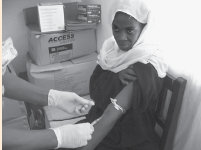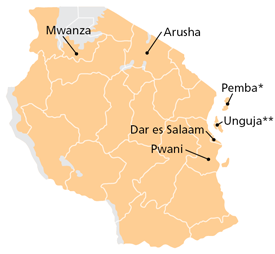Integrating tuberculosis and HIV services in Tanzania
Many people living with HIV face another formidable foe: tuberculosis (TB). Although TB rates have been greatly reduced in wealthy countries, the disease continues to threaten millions of people in low-resource countries. TB is now the leading cause of death among people living with HIV, and the number of people infected with both diseases is growing rapidly. Worldwide, however, few people with TB are routinely tested for HIV, and even fewer people with HIV are screened for TB.

A TB patient giving a sample of blood for rapid HIV testing as a TB clinic in Dar es Salaam. Photo: PATH/Fat-hia Amri
In Tanzania, where about half of all people newly diagnosed with TB are also infected with HIV, PATH is working with the public and private health sectors to integrate services to prevent disease and better meet the needs of people living with both infections. With funding from the US Government, PATH is implementing a TB–HIV integration project to strengthen health systems and improve epidemic response.
PATH is collaborating with local and national partners, health care programs, and international partners to implement a coordinated response across Tanzania’s entire health system. Our efforts aim to scale up and improve integrated services, strengthen the private-sector delivery of TB services, enhance health professionals’ ability to identify and track cases and provide treatment, improve laboratory diagnostic services, and engage and educate communities.
Supporting and assessing service management
Health care providers need both tools and knowledge to deliver high-quality care and effective services. PATH has formed partnerships with government and private-sector providers and works in several regions to encourage use of services. In addition, we offer training and technical support to private facilities, which in turn provide low-cost TB services to patients receiving care in the private sector.
Communities also play an integral role in our work. PATH has spearheaded a national effort to educate communities about free TB and TB–HIV services, heighten awareness, reduce stigma, and encourage people to get tested and seek care. Our work includes posting billboards on the availability of services at project-supported facilities; providing brochures and posters that will increase awareness and encourage people to seek health care; and training community groups on the basics of TB–HIV and on communication to support the establishment of TB–HIV information, education, and communication committees in their villages.
We have also worked to obtain support and input from government and private health facilities for a national TB–HIV advocacy, communication, and social mobilization strategy, which we are developing with the government of Tanzania. In addition, we have developed assessment tools to determine whether private-sector facilities have the capacity to provide TB services and to identify the upgrades and inventory needed in public-sector diagnostic laboratories.
Scaling up human resources

PATH works in nine heavily populated regions (four on the mainland and five on the island of Zanzibar) that account for approximately 25% of Tanzania's total population.
Health care workers’ capabilities are critical in expanding integrated TB–HIV services. With PATH’s support, Tanzania has trained almost 600 health workers to offer integrated services, and TB–HIV services have been introduced at nearly 200 public sector facilities and 70 private-sector facilities in nine of 26 regions throughout the country. The private sector now contributes approximately one-third of integrated services within the project regions—all at minimal cost to the patients.
Our management of project staff has played a key role in accelerating the expansion and integration of services. PATH has worked with partners to hire district and zonal TB–HIV coordinators who provide critical on-the-job training and supportive supervision to health workers. These coordinators have been instrumental in expanding services and advocating for more, monitoring service implementation, and mobilizing resources.
District and zonal coordinators represent both a new approach to disease management in Tanzania and a potential solution for long-term success. It is critical that PATH plan carefully to ensure that our eventual exit will not jeopardize the sustainability of this approach. We are working to demonstrate the effectiveness of the coordinators to build government and donor support for the national scale-up and adoption of this model. In addition, we are working closely with Tanzania’s national TB program and local authorities to determine how best to transition services and employees into the national health system and to chart a plan for adopting this approach countrywide.
Tracking information and monitoring the epidemics
To manage the TB and TB–HIV burden, health care workers must have up-to-date information on disease rates within their zones and districts as well as information on the stock of drugs and other supplies needed to diagnose, manage, and treat the diseases. PATH has trained providers on using national TB and TB–HIV recording and reporting tools and has supplied 26 regional health management teams with computers, internet connections, and data-monitoring software.
Sustaining success through policy
A strengthened health system must be supported by effective national policies. PATH has helped the government of Tanzania develop national TB–HIV guidelines for treatment, operations, and standards of care that match internationally established practices and norms. We have also worked with our partners to publish a policy for TB and TB–HIV services and referral directories. These practices and guidelines will serve as a road map for Tanzania and its partners as they work to lessen the burden of these two epidemics. They also demonstrate that high-quality TB–HIV services can be provided and scaled up in low-resource settings.
Adapted with permission from the PATH website, February 2009.